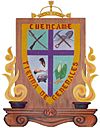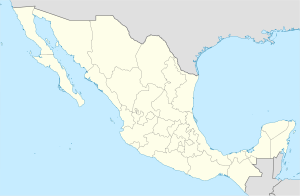Cuencamé facts for kids
Quick facts for kids
Cuencamé
|
||
|---|---|---|
|
||
| Nickname(s):
Land of Generals
|
||
| Country | ||
| State | Durango | |
| Founded | Late 16th century | |
| Elevation | 1,580 m (5,180 ft) | |
| Population
(2015)
|
||
| • Total | 9,848 | |
| • Demonym | Cuencamense | |
| Time zone | UTC-6 (Central Standard Time) | |
| • Summer (DST) | UTC-5 (Central Daylight Time) | |
| Website | http://www.cuencame.com.mx | |
Cuencamé is a small city in northern Mexico. It is located in the state of Durango. Cuencamé is also the main town of the larger municipality of Cuencamé. In 2015, about 9,848 people lived in the city.
Contents
Discover Cuencamé City
Cuencamé started as a very small town. Different groups of people lived there. These included the Zacatecos, Tepehuanos, and Laguneros.
A Jesuit priest named Francisco Ramírez officially founded Cuencamé. He started a mission there in August 1594. This was 11 years after an earlier mission had been left empty. Cuencamé is in a dry area. Many people came here because of the silver mines nearby.
Famous People from Cuencamé
Many important people have lived in Cuencamé.
- Early Times:
- Agustín de Espinoza was a priest in the early Colonial period.
- Jerónimo Ramírez, another Jesuit priest, arrived in August 1594.
- Francisco Santos was a famous monk. He was in charge of the Saint Anthony monastery.
- Carlos Michaud founded the village of Pedriceña. He was a captain during the Colonial period.
- Mexican Revolution:
- Calixto Contreras (1867–1918)
- Severino Ceniceros (1880–1937)
These two important figures were born in the Cuencamé area. They played a big part in the Mexican Revolution.
The Cuencamé Region
The area around Cuencamé is a wide valley. It is surrounded by beautiful mountains.
How the Region Grew
Father Jerónimo Ramírez described the area in 1594. He worked hard to help people settle there. A letter from Rodrigo de Paz says that Captain Martin de Zapata arrived. Local leaders from Manganapa, Salina, and Rio of Nazas met him. They received land to settle.
In 1622, the Saint Anthony monastery was led by Friar Francis Santos. Later, its name changed to Purisima Concepción. This might have been to tell it apart from other places in Durango. Franciscan monks came to the area in 1583.
The region had many mines. The Terneras mine was very important. The American Smelting and Refining Company built a plant there. They mined so much silver that the veins eventually ran out.
Cuencamé's Geography
Cuencamé is in the western part of the state of Durango. It is one of the largest areas in the state.
Where is Cuencamé Located?
Cuencamé shares borders with several other areas:
- To the north: Nazas and Lerdo.
- To the east: Simon Bolivar and Santa Clara.
- To the west: Poanas, Guadalupe Victoria, and Peñon Blanco.
- To the south: The state of Zacatecas.
The community of Pedriceña is inside the municipality. Carlos Michaud founded it. It was named after Captain Pedroza. Pedriceña was almost its own independent municipality.
Cuencamé is located at 24° 52’ North and 103°42’ West. It is about 146 kilometers (90 miles) from the state capital. The area is about 1580 meters (5,184 feet) above sea level.
Weather in Cuencamé
The area has a dry, or semiarid, climate. The land is mostly flat, with mountains around it.
The average temperature is about 21.1 °C (70 °F). The area gets about 375.8 millimeters (14.8 inches) of rain each year.
| Climate data for Cuencamé, Durango | |||||||||||||
|---|---|---|---|---|---|---|---|---|---|---|---|---|---|
| Month | Jan | Feb | Mar | Apr | May | Jun | Jul | Aug | Sep | Oct | Nov | Dec | Year |
| Record high °C (°F) | 36.5 (97.7) |
39.0 (102.2) |
43.0 (109.4) |
41.5 (106.7) |
43.5 (110.3) |
44.0 (111.2) |
41.5 (106.7) |
39.5 (103.1) |
45.5 (113.9) |
40.0 (104.0) |
40.5 (104.9) |
39.5 (103.1) |
45.5 (113.9) |
| Mean daily maximum °C (°F) | 23.6 (74.5) |
26.3 (79.3) |
29.5 (85.1) |
32.3 (90.1) |
34.6 (94.3) |
34.6 (94.3) |
32.7 (90.9) |
32.0 (89.6) |
30.5 (86.9) |
29.3 (84.7) |
26.7 (80.1) |
23.7 (74.7) |
29.7 (85.5) |
| Daily mean °C (°F) | 14.9 (58.8) |
16.9 (62.4) |
19.9 (67.8) |
23.0 (73.4) |
25.6 (78.1) |
26.3 (79.3) |
25.1 (77.2) |
24.5 (76.1) |
23.0 (73.4) |
21.1 (70.0) |
18.1 (64.6) |
15.3 (59.5) |
21.1 (70.0) |
| Mean daily minimum °C (°F) | 6.3 (43.3) |
7.6 (45.7) |
10.3 (50.5) |
13.7 (56.7) |
16.5 (61.7) |
18.0 (64.4) |
17.5 (63.5) |
17.0 (62.6) |
15.6 (60.1) |
13.0 (55.4) |
9.5 (49.1) |
7.0 (44.6) |
12.7 (54.9) |
| Record low °C (°F) | −9.0 (15.8) |
−3.0 (26.6) |
−5.0 (23.0) |
0.5 (32.9) |
7.5 (45.5) |
9.5 (49.1) |
9.5 (49.1) |
8.5 (47.3) |
6.5 (43.7) |
2.0 (35.6) |
−5.0 (23.0) |
−7.0 (19.4) |
−9.0 (15.8) |
| Average precipitation mm (inches) | 9.4 (0.37) |
5.7 (0.22) |
4.3 (0.17) |
5.4 (0.21) |
13.4 (0.53) |
47.3 (1.86) |
78.5 (3.09) |
94.5 (3.72) |
72.6 (2.86) |
27.2 (1.07) |
8.8 (0.35) |
8.7 (0.34) |
375.8 (14.80) |
| Average precipitation days (≥ 0.1 mm) | 1.8 | 1.1 | 0.8 | 1.2 | 2.6 | 6.7 | 10.4 | 11.2 | 8.0 | 4.6 | 1.6 | 1.9 | 51.9 |
| Average snowy days | 0.10 | 0 | 0 | 0 | 0 | 0 | 0 | 0 | 0 | 0 | 0 | 0.11 | 0.21 |
| Source 1: Servicio Meteorológico National | |||||||||||||
| Source 2: Colegio de Postgraduados | |||||||||||||
Mountains Around Cuencamé
The San Lorenzo mountains are north of the township. The Huarichic Canyon is between these mountains. A main highway and a railroad run through this canyon. The San Lorenzo range has high peaks. The San Isidro peak is a notable part of this mountain chain.
The Velardeña valley has rich mineral mines. It marks the town limit for the village of Velardeña. The Sierra de Guadalupe runs parallel to the Sierra de Jimulco. These two mountain ranges form a wide canyon. The Aguanaval river and the Central railroad run through it. This is known as the "Jimulco Canyon."
The Aguanaval River flows into the Nazas River. The Nazas River is the main river in this area. The land around these mountains is dry. You can see the layers of rock from the Cretaceous period.
Rivers, Lakes, and Springs
The main water source is the Cuencamé stream. Many small streams flow into it, especially during the rainy season. Another stream near San Pedro Ocuila is called “Arrieras.”
In recent years, many of these streams have become much smaller. The Cuencamé stream eventually flows into the Nazas River. This happens at a place called Rancho de Fernández. In the 1950s, two dams were built. They help store mountain water for farming in the northern area.
See also
 In Spanish: Cuencamé para niños
In Spanish: Cuencamé para niños



